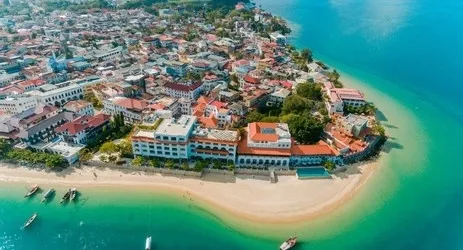Introduction:
Tanzania, a country nestled in the heart of East Africa, is known for its diverse cultural heritage and breathtaking natural wonders. From towering mountains to pristine beaches, this African gem offers a rich tapestry of history and beauty. In this article, we will delve into the best historical places to visit in Tanzania, exploring its famous landmarks and historical sites that showcase the country's vibrant past.
1. The Stone Town of Zanzibar:
Located on the enchanting island of Zanzibar, the Stone Town is a UNESCO World Heritage Site and an embodiment of Tanzania's rich cultural fusion. This historical trading hub boasts narrow alleys, intricately carved wooden doors and ancient architecture that reflect a blend of African, Arab, Persian, and European influences. Delve into the maze-like streets, visit the Sultan's Palace, and immerse yourself in the fascinating history of this vibrant town.
2. Kilwa Kisiwani:
Situated on an island off the southern coast of Tanzania, Kilwa Kisiwani is an archaeological site that transports visitors back in time. Once a thriving trading center and the capital of the Kilwa Sultanate, this UNESCO World Heritage Site features ruins of palaces, mosques, and a Great Mosque with a towering minaret. Explore the remnants of this medieval city and marvel at its architectural grandeur.
3. The Olduvai Gorge:
For those intrigued by the origins of humankind, the Olduvai Gorge is an absolute must-visit. Located in the Great Rift Valley, this significant archaeological site has yielded remarkable fossil discoveries, including early hominid remains that date back millions of years. Immerse yourself in the captivating exhibitions at the Olduvai Gorge Museum and gain insights into our ancient ancestors and their evolutionary journey.
4. Bagamoyo:
Once a prominent trading port and a key slave market on the East African coast, Bagamoyo now stands as a poignant reminder of Tanzania's dark past. Explore the historic ruins, visit the Bagamoyo Arts Center, and delve into the moving exhibits at the Bagamoyo Slave Market Museum. This town is a testament to the resilience of its people and serves as an important cultural and historical landmark in Tanzania.
5. The Ruins of Kilwa Kivinje:
Nestled on the southern coast of Tanzania, the ruins of Kilwa Kivinje showcase the remnants of a once-thriving Swahili trading town. As you explore these ancient ruins, you'll discover mosques, tombs, and remnants of a defensive wall that give insights into the town's vibrant past. Take a moment to admire the stunning coastal views and reflect on the historical significance of this remarkable site.
6. Ngorongoro Conservation Area:
The Ngorongoro Conservation Area, a UNESCO World Heritage Site, is a haven for both wildlife and cultural heritage. The centerpiece of the area is the magnificent Ngorongoro Crater, a massive volcanic caldera teeming with diverse wildlife, including lions, elephants, and rhinos. In addition to its natural wonders, the conservation area is home to the Maasai people, known for their rich cultural traditions and colorful attire. Engage with the Maasai community, learn about their customs, and witness their traditional dances to truly appreciate the cultural significance of this remarkable place.
7. Great Mosque of Kilwa:
Located on the island of Kilwa Kisiwani, the Great Mosque stands as a testament to the region's historical significance as a center of trade and Islamic culture. Constructed in the 14th century, this grand mosque showcases intricate Swahili architecture and a large prayer hall adorned with beautiful columns and arches. Marvel at the craftsmanship and immerse yourself in the atmosphere of this sacred place, which still serves as an active place of worship.
8. Old Fort of Zanzibar:
The Old Fort, also known as Ngome Kongwe, is a historic fortification located in Stone Town, Zanzibar. Built-in the 17th century by the Omani Arabs, this fortress once protected the island from invasions. Today, it serves as a cultural hub, hosting vibrant events such as the Zanzibar International Film Festival and the Stone Town Cultural Festival. Explore the fort's ancient walls, visit the open-air amphitheater, and soak in the artistic and cultural vibes that permeate this iconic landmark.
9. Isimila Stone Age Site:
Deep in the southern highlands of Tanzania lies the Isimila Stone Age Site, a fascinating archaeological site known for its prehistoric artifacts. This open-air museum offers a glimpse into the lives of early humans who inhabited the region over 60,000 years ago. Wander among the large stone tools and remnants of ancient campsites, and let your imagination transport you to a time long gone.
10. German Boma Museum:
In the coastal city of Tanga, the German Boma Museum stands as a testament to Tanzania's colonial history. Housed in a former administrative building constructed during the German colonial period, this museum showcases artifacts, photographs, and exhibits that depict Tanga's past as a German East Africa colony. Gain insights into the region's history, including the struggle for independence, and appreciate the architectural charm of this historical building.
Conclusion:
Tanzania's cultural tapestry extends beyond the previously mentioned landmarks, with the Ngorongoro Conservation Area, Great Mosque of Kilwa, Old Fort of Zanzibar, Isimila Stone Age Site, and German Boma Museum offering unique perspectives into the country's diverse heritage. From breathtaking natural wonders to architectural marvels and archaeological sites, these additional five places enhance the richness and depth of Tanzania's historical and cultural significance. Embark on a remarkable journey through Tanzania's past and present, and allow these landmarks to captivate your imagination and ignite a deeper appreciation for this enchanting country.
